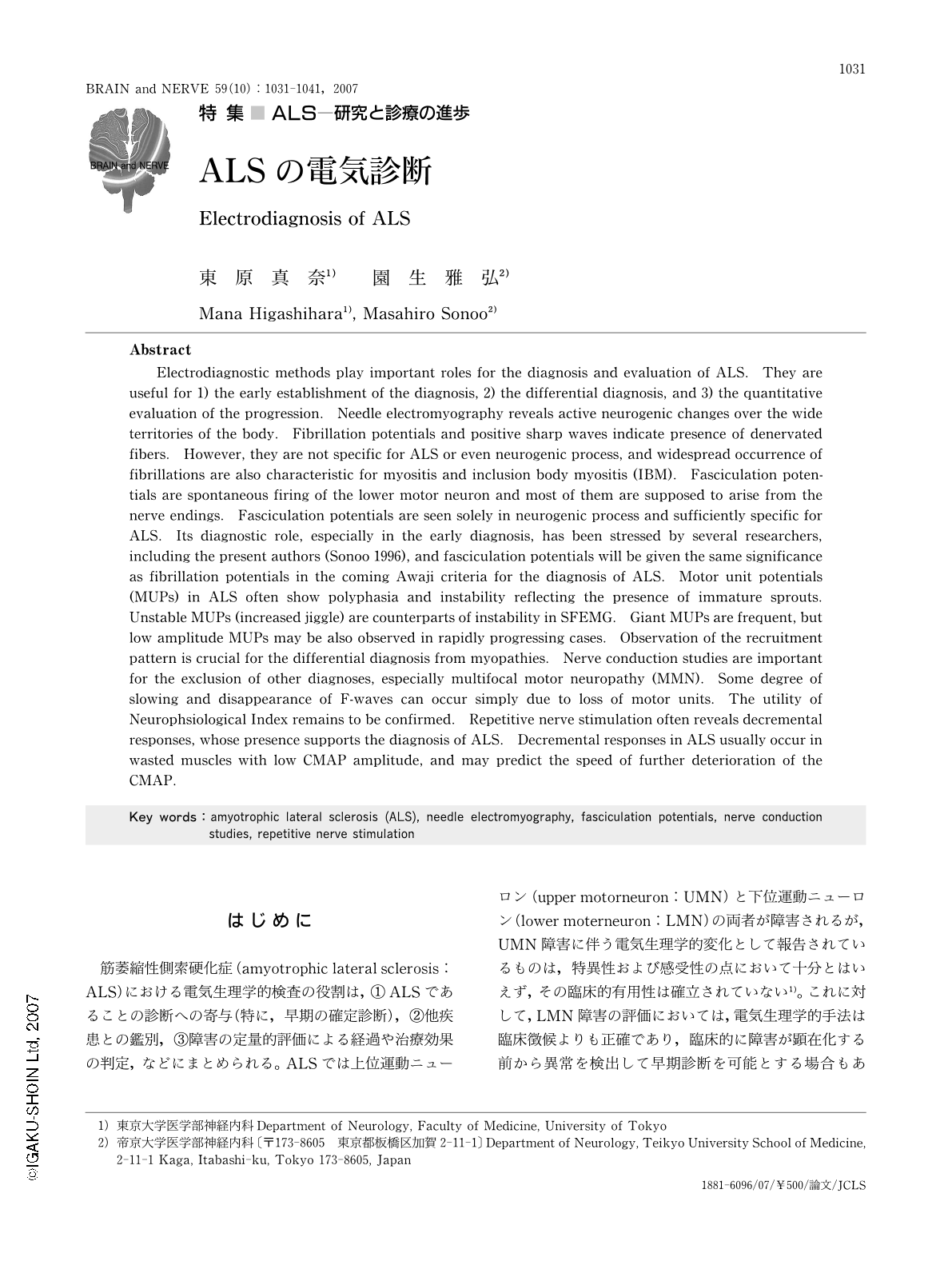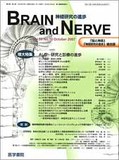Japanese
English
- 有料閲覧
- Abstract 文献概要
- 1ページ目 Look Inside
- 参考文献 Reference
はじめに
筋萎縮性側索硬化症(amyotrophic lateral sclerosis:ALS)における電気生理学的検査の役割は,①ALSであることの診断への寄与(特に,早期の確定診断),②他疾患との鑑別,③障害の定量的評価による経過や治療効果の判定,などにまとめられる。ALSでは上位運動ニューロン(upper motorneuron:UMN)と下位運動ニューロン(lower moterneuron:LMN)の両者が障害されるが,UMN障害に伴う電気生理学的変化として報告されているものは,特異性および感受性の点において十分とはいえず,その臨床的有用性は確立されていない1)。これに対して,LMN障害の評価においては,電気生理学的手法は臨床徴候よりも正確であり,臨床的に障害が顕在化する前から異常を検出して早期診断を可能とする場合もあり,有用性が高い。他疾患で説明できないような広汎な領域にわたってLMN障害が認められれば,十分な信頼性をもってALSの診断を下すことができる。LMN障害の検出において,電気生理学的検査は臨床症候の延長上にあるといえ,臨床症候を確認および補完する役割を果たす。既存の診断基準においてもそのように位置付けられている2)。
ALSの診断はまた除外診断でもある。鑑別疾患としては,頸椎症性脊髄症や腰部脊柱管狭窄症などの脊椎症,平山病,慢性炎症性脱髄性多発根神経炎(CIDP)および多巣性運動ニューロパチー(MMN),慢性運動性軸索性ニューロパチー(CMAN),ポリオ,他の運動ニューロン疾患〔球脊髄性筋萎縮症(SBMA),脊髄性筋萎縮症(SMA)など〕,筋炎,とりわけ封入体筋炎(IBM),その他の慢性ミオパチーなどが挙げられる。ALSの診断の重大性とその患者に与える影響を鑑みると,電気診断医にはALSや上記鑑別疾患に関する十分な知識と経験に基づいた,質の高い電気生理学的検査が要求される2)。
以下,本稿ではALSにおける各種電気生理学的所見の特徴や問題点について,検査項目別に論じていくこととする。なお,近年ALSの進行度の客観的評価方法の1つとして用いられるようになった運動単位数推定法(MUNE)と,UMN障害の研究手段として用いられる磁気刺激法については,本特集の別稿で扱われるので,本稿では触れない。
Abstract
Electrodiagnostic methods play important roles for the diagnosis and evaluation of ALS. They are useful for 1) the early establishment of the diagnosis, 2) the differential diagnosis, and 3) the quantitative evaluation of the progression. Needle electromyography reveals active neurogenic changes over the wide territories of the body. Fibrillation potentials and positive sharp waves indicate presence of denervated fibers. However, they are not specific for ALS or even neurogenic process, and widespread occurrence of fibrillations are also characteristic for myositis and inclusion body myositis (IBM). Fasciculation potentials are spontaneous firing of the lower motor neuron and most of them are supposed to arise from the nerve endings. Fasciculation potentials are seen solely in neurogenic process and sufficiently specific for ALS. Its diagnostic role, especially in the early diagnosis, has been stressed by several researchers, including the present authors (Sonoo 1996), and fasciculation potentials will be given the same significance as fibrillation potentials in the coming Awaji criteria for the diagnosis of ALS. Motor unit potentials (MUPs) in ALS often show polyphasia and instability reflecting the presence of immature sprouts. Unstable MUPs (increased jiggle) are counterparts of instability in SFEMG. Giant MUPs are frequent, but low amplitude MUPs may be also observed in rapidly progressing cases. Observation of the recruitment pattern is crucial for the differential diagnosis from myopathies. Nerve conduction studies are important for the exclusion of other diagnoses, especially multifocal motor neuropathy (MMN). Some degree of slowing and disappearance of F-waves can occur simply due to loss of motor units. The utility of Neurophsiological Index remains to be confirmed. Repetitive nerve stimulation often reveals decremental responses, whose presence supports the diagnosis of ALS. Decremental responses in ALS usually occur in wasted muscles with low CMAP amplitude, and may predict the speed of further deterioration of the CMAP.

Copyright © 2007, Igaku-Shoin Ltd. All rights reserved.


